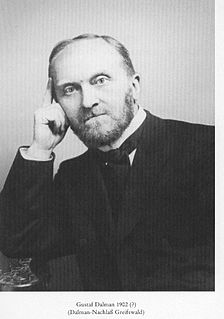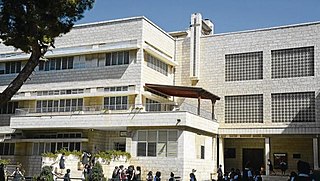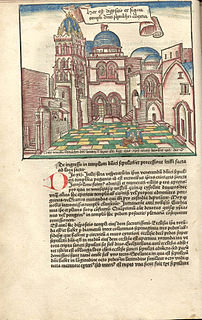
Samuel Gobat was a Swiss Calvinist who became an Anglican missionary in Africa and was the Protestant Bishop of Jerusalem from 1846 until his death.

Tabgha is an area situated on the north-western shore of the Sea of Galilee in Israel. It is traditionally accepted as the place of the miracle of the multiplication of the loaves and fishes and the fourth resurrection appearance of Jesus after his Crucifixion. Between the Late Muslim period and 1948, it was the site of a Palestinian Arab village.

Gottlob Christoph Jonathan Hoffmann was born in Leonberg in the Kingdom of Württemberg, Germany. His parents were Beate Baumann (1774-1852) and Gottlieb Wilhelm Hoffmann (1771-1846), who was chairman of the Unitas Fratrum congregation in Korntal. Gottlieb's theological thinking was inspired by reading the works of Johann Albrecht Bengel, whose studies had led him to the conclusion that Christ would return in 1836.

The Catholic Church in Israel is part of the worldwide Catholic Church, in full communion with the Holy See in Rome.

Bethany or what is locally known as Al-Eizariya or al-Azariya, is a town in the West Bank. The name al-Eizariya refers to the New Testament figure Lazarus of Bethany, who according to the Gospel of John, was raised from the dead by Jesus. The traditional site of the miracle, the Tomb of Lazarus, in the city is a place of pilgrimage.

Dieter Vieweger, a German Biblical scholar and Prehistorian Archaeologist, was born in Chemnitz, East Germany in 1958.

Abbey of the Dormition is a Catholic abbey belonging to the Benedictine Order in Jerusalem, on Mount Zion just outside the walls of the Old City near the Zion Gate. The Abbey is said to mark the spot where Mary, mother of Jesus, died.

The German Colony was established in Ottoman Haifa in 1868 as a German Templer Colony in Palestine. It was the first of several colonies established by the group in the Holy Land. Others were founded in Sarona near Jaffa, Galilee and Jerusalem.

Gustaf Hermann Dalman was a German Lutheran theologian and orientalist. He did extensive field work in Palestine before the First World War, collecting inscriptions, poetry, and proverbs. He also collected physical articles illustrative of the life of the indigenous farmers and herders of the country, including rock and plant samples, house and farm tools, small archaeological finds, and ceramics. He pioneered the study of biblical and early post-biblical Aramaic, publishing an authoritative grammar (1894) and dictionary (1901), as well as other works. His collection of 15,000 historic photographs and 5,000 books, including rare 16th century prints, and maps formed the basis of the Gustaf Dalman Institute at the Ernst Moritz Arndt University, Greifswald, which commemorates and continues his work.

The Church of the Multiplication of the Loaves and Fish, shortened to the Church of the Multiplication, is a Roman Catholic church located at Tabgha, on the northwest shore of the Sea of Galilee in Israel. The modern church rests on the site of two earlier churches.

The Holy See has maintained relations with Palestine since 11 February 1948, when the Holy See created the office of Apostolic Delegate to Jerusalem and Palestine, with jurisdiction over Palestine, Transjordania, and Cyprus. In Vatican usage, an Apostolic Delegate is a representative of the Vatican in a country with which the Holy See has no diplomatic ties, and who is not accredited to the government of the country. The Delegate also acts as a liaison with the Catholic Church in that country.

Conrad Schick (1822–1901) was a German architect, archaeologist and Protestant missionary who settled in Jerusalem in the mid-nineteenth century. For many decades he was head of the "House of Industry" at the Christ Church, which was the institute for vocational training of the London Society for Promoting Christianity Amongst the Jews.

Khirbat al-Minya, also known as Ayn Minyat Hisham (Arabic) or Horvat Minnim (Hebrew) is an Umayyad-built palace in the eastern Galilee, Israel, located about 200 meters (660 ft) west of the northern end of Lake Tiberias. It was erected as a qasr complex, with a palace, mosque, and bath built by a single patron.

Russian Orthodox properties in Israel refers to real-estate owned by the Russian Orthodox Church (ROC) in Israel.

Schmidt's Girls College is an international German school for Christian and Muslim girls, located in East Jerusalem. It was founded in 1886 and approximately 500 pupils attend the school today. It includes a grundschule program, as well as the Deutsche Internationale Abiturprüfung program. It also offers a Tawjihi program. Although it is owned and supported by the German Association of the Holy Land, it is currently in the care of the international convent of the Sisters of the Congregation of Jesus. Lessons are taught in German and the spoken language outside of class is English. The teaching staff is composed of both Arab and German teachers.

The Paulus-Haus is a pilgrim hospice in Jerusalem under the care of the German Association of the Holy Land. It is situated on the Nablus Road in the Eastern part of the modern city, directly opposite the Damascus Gate of the Old City. The monumental architecture is reminiscent of the crusader castles.

Bernhard von Breidenbach was a politician in the Electorate of Mainz. He wrote a travel report, Peregrinatio in terram sanctam (1486), from his travels to the Holy Land.

The Austrian Pilgrim Hospice to the Holy Family is a pilgrims hostel of the Austrian Catholic Church in the Old City of Jerusalem. It is located at the corner of Via Dolorosa and El Wad Street in the Arab quarter of the old city, at the 3rd station of the Way of the Cross. Markus Stefan Bugnyar has been rector of the hospice since 2004. Founded in 1856 and opened on 19 March 1863, the hospice is the oldest national pilgrim house in the Holy Land. The Church of the Holy Family is located inside the main building.

Wilhelm II's voyage to the Levant in 1898 was a state visit that the German Emperor undertook in the Ottoman Empire between 25 October and 12 November 1898.
The German Templer colonies in Palestine were the settlements established in Ottoman Palestine and Mandatory Palestine by the German Pietist Templer movement in the late 19th and early 20th century. The colonies were depopulated during and shortly after World War II.





















